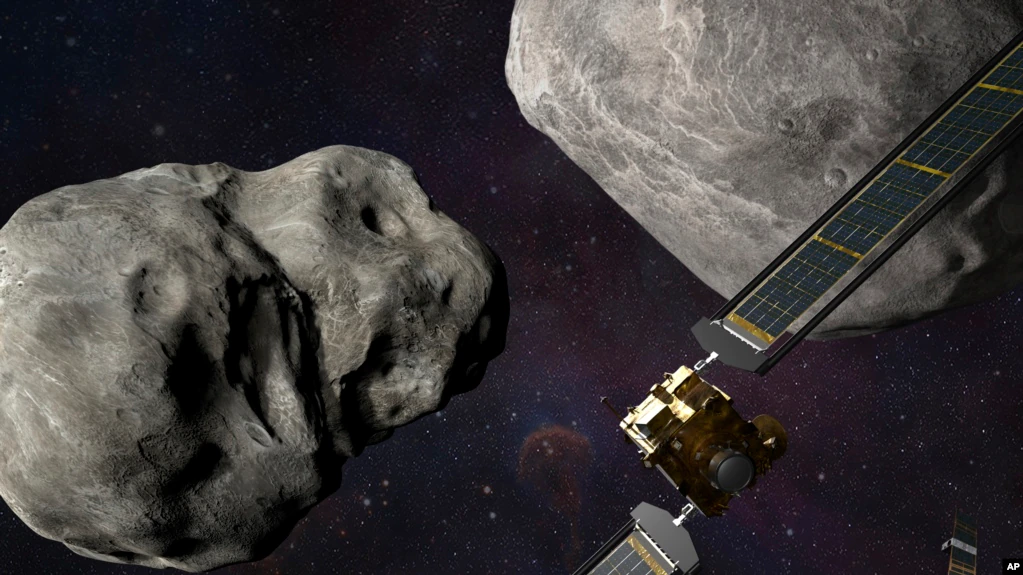WASHINGTON: In the first-of-its kind, save-the-world experiment, NASA is about to clobber a small, harmless asteroid millions of miles away.
A spacecraft named Dart will zero in on the asteroid Monday, intent on slamming it head-on at 14,000 mph (22,500 kph).
The impact should be just enough to nudge the asteroid into a slightly tighter orbit around its companion space rock — demonstrating that if a killer asteroid ever heads our way, we’d stand a fighting chance of diverting it.
“This is stuff of science-fiction books and really corny episodes of “StarTrek” from when I was a kid, and now it’s real,” NASA program scientist Tom Statler said Thursday.
Cameras and telescopes will watch the crash, but it will take days or even weeks to find out if it actually changed the orbit.
The $325 million planetary defense test began with Dart’s launch last fall.
Asteroid target
The asteroid with the bull’s-eye on it is Dimorphos, about 7 million miles (9.6 million kilometers) from Earth. It is actually the puny sidekick of a 2,500-foot (780-meter) asteroid named Didymos, Greek for twin.
Discovered in 1996, Didymos is spinning so fast that scientists believe it flung off material that eventually formed a moonlet. Dimorphos — roughly 525 feet (160 meters) across — orbits its parent body at a distance of less than a mile (1.2 kilometers).
“This really is about asteroid deflection, not disruption,” said Nancy Chabot, a planetary scientist and mission team leader at Johns Hopkins University’s Applied Physics Laboratory, which is managing the effort.
“This isn’t going to blow up the asteroid. It isn’t going to put it into lots of pieces.” Rather, the impact will dig out a crater tens of yards (meters) in size and hurl some 2 million pounds (1 million kilograms) of rocks and dirt into space.
NASA insists there’s a zero chance either asteroid will threaten Earth — now or in the future. That’s why the pair was picked.
Dart, the impactor
The Johns Hopkins lab took a minimalist approach in developing Dart — short for Double Asteroid Redirection Test — given that it’s essentially a battering ram and faces sure destruction.
It has a single instrument: a camera used for navigating, targeting and chronicling the final action. Believed to be essentially a rubble pile, Dimorphos will emerge as a point of light an hour before impact, looming larger and larger in the camera images beamed back to Earth.
Managers are confident Dart won’t smash into the larger Didymos by mistake. The spacecraft’s navigation is designed to distinguish between the two asteroids and, in the final 50 minutes, target the smaller one.
The size of a small vending machine at 1,260 pounds (570 kilograms), the spacecraft will slam into roughly 11 billion pounds (5 billion kilograms) of asteroid. “Sometimes we describe it as running a golf cart into a Great Pyramid,” said Chabot.
Unless Dart misses — NASA puts the odds of that happening at less than 10% — it will be the end of the road for Dart. If it goes screaming past both space rocks, it will encounter them again in a couple years for Take 2.
Saving earth
Little Dimorphos completes a lap around big Didymos every 11 hours and 55 minutes. The impact by Dart should shave about 10 minutes off that.
Although the strike itself should be immediately apparent, it could take a few weeks or more to verify the moonlet’s tweaked orbit. Cameras on Dart and a mini tagalong satellite will capture the collision up close.
Telescopes on all seven continents, along with the Hubble and Webb space telescopes and NASA’s asteroid-hunting Lucy spacecraft, may see a bright flash as Dart smacks Dimorphos and sends streams of rock and dirt cascading into space.
The observatories will track the pair of asteroids as they circle the sun, to see if Dart altered Dimorphos’ orbit. In 2024, a European spacecraft named Hera will retrace Dart’s journey to measure the impact results.
Although the intended nudge should change the moonlet’s position only slightly, that will add up to a major shift over time, according to Chabot.
“So if you were going to do this for planetary defense, you would do it five, 10, 15, 20 years in advance in order for this technique to work,” she said. Even if Dart misses, the experiment still will provide valuable insight, said NASA program executive Andrea Riley. “This is why we test. We want to do it now rather than when there’s an actual need,” she said.
Asteroid missions galore
Planet Earth is on an asteroid-chasing roll. NASA has close to a pound (450 grams) of rubble collected from asteroid Bennu headed to Earth.
The stash should arrive next September. Japan was the first to retrieve asteroid samples, accomplishing the feat twice.
China hopes to follow suit with a mission launching in 2025. NASA’s Lucy spacecraft, meanwhile, is headed to asteroids near Jupiter, after launching last year.
Another spacecraft, Near-Earth Asteroid Scout, is loaded into NASA’s new moon rocket awaiting liftoff; it will use a solar sail to fly past a space rock that’s less than 60 feet (18 meters) next year.
In the next few years, NASA also plans to launch a census-taking telescope to identify hard-to-find asteroids that could pose risks.
One asteroid mission is grounded while an independent review board weighs its future. NASA’s Psyche spacecraft should have launched this year to a metal-rich asteroid between Mars and Jupiter, but the team couldn’t test the flight software in time.
Hollywood’s take
Hollywood has churned out dozens of killer-space-rock movies over the decades, including 1998′s “Armageddon” which brought Bruce Willis to Cape Canaveral for filming, and last year’s “Don’t Look Up” with Leonardo DiCaprio leading an all-star cast.
NASA’s planetary defense officer, Lindley Johnson, figures he’s seen them all since 1979′s “Meteor,” his personal favorite “since Sean Connery played me.”
While some of the sci-fi films are more accurate than others, he noted, entertainment always wins out. The good news is that the coast seems clear for the next century, with no known threats.
Otherwise, “it would be like the movies, right?” said NASA’s science mission chief Thomas Zurbuchen. What’s worrisome, though, are the unknown threats.
Fewer than half of the 460-foot (140-meter) objects have been confirmed, with millions of smaller but still-dangerous objects zooming around.
“These threats are real, and what makes this time special, is we can do something about it,” Zurbuchen said. Not by blowing up an asteroid as Willis’ character did — that would be a last, last-minute resort — or by begging government leaders to take action as DiCaprio’s character did in vain. If time allows, the best tactic could be to nudge the menacing asteroid out of our way, like Dart.
(VOA)









Comment